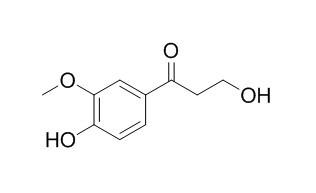beta-Hydroxypropiovanillone
beta-Hydroxypropiovanillone, an achiral compound, which is further degraded by lignin degradation. It shows tyrosinase inhibitory activities.
Inquire / Order:
manager@chemfaces.com
Technical Inquiries:
service@chemfaces.com
Tel:
+86-27-84237783
Fax:
+86-27-84254680
Address:
1 Building, No. 83, CheCheng Rd., Wuhan Economic and Technological Development Zone, Wuhan, Hubei 430056, PRC
Providing storage is as stated on the product vial and the vial is kept tightly sealed, the product can be stored for up to
24 months(2-8C).
Wherever possible, you should prepare and use solutions on the same day. However, if you need to make up stock solutions in advance, we recommend that you store the solution as aliquots in tightly sealed vials at -20C. Generally, these will be useable for up to two weeks. Before use, and prior to opening the vial we recommend that you allow your product to equilibrate to room temperature for at least 1 hour.
Need more advice on solubility, usage and handling? Please email to: service@chemfaces.com
The packaging of the product may have turned upside down during transportation, resulting in the natural compounds adhering to the neck or cap of the vial. take the vial out of its packaging and gently shake to let the compounds fall to the bottom of the vial. for liquid products, centrifuge at 200-500 RPM to gather the liquid at the bottom of the vial. try to avoid loss or contamination during handling.
Environ Toxicol Pharmacol.2019, 66:109-115
Process Biochemistry2019, 87:213-220
Molecules.2024, 29(5):1048.
Front Chem.2022, 10:1048467.
Phytomedicine.2022, 100:154036.
Pharmaceuticals (Basel).2020, 13(10):302.
Anticancer Res.2021, 41(3):1357-1364.
Plants.2024, 13(10):1348;
Invest New Drugs.2017, 35(2):166-179
J Adv Res.2019, 17:85-94
Related and Featured Products
Nat Prod Commun. 2012 Feb;7(2):185-6.
Phenolic constituents from the heartwood of Artocapus altilis and their tyrosinase inhibitory activity.[Pubmed:
22474950]
METHODS AND RESULTS:
From the MeOH extract of the heartwood of Artocapus altilis, thirteen phenolic compounds have been isolated, namely curcumin (1), desmethoxycurcumin (2), retrodihydrochalcone (3), apigenin (4), tangeretin (5), nobiletin (6), O-methyldehydrodieugenol (7), dehydrodieugenol (8), beta-Hydroxypropiovanillone (9), p-coumaric acid (10), p-hydroxybenzaldehyde (11), vanillin (12), and vanillic acid (13). This is the first report on the presence of these compounds in the heartwood of A. altilis.
CONCLUSIONS:
Compounds 1, 2, and 10 showed more potent tyrosinase inhibitory activities, with IC50 values ranging from 2.3 to 42.0 microM, than the positive control kojic acid (IC50, 44.6 microM). The most active compound, p-coumaric acid (10) (IC50, 2.3 microM), was 22 times more active in tyrosinase inhibitory activity than kojic acid.
J Bacteriol. 2003 Mar;185(6):1768-75.
Roles of the enantioselective glutathione S-transferases in cleavage of beta-aryl ether.[Pubmed:
12618439 ]
Cleavage of the beta-aryl ether linkage is the most important process in lignin degradation.
METHODS AND RESULTS:
Here we characterize the three tandemly located glutathione S-transferase (GST) genes, ligF, ligE, and ligG, from low-molecular-weight lignin-degrading Sphingomonas paucimobilis SYK-6, and we describe the actual roles of these genes in the beta-aryl ether cleavage. Based on the identification of the reaction product by electrospray ionization-mass spectrometry, a model compound of beta-aryl ether, alpha-(2-methoxyphenoxy)-beta-Hydroxypropiovanillone (MPHPV), was transformed by LigF or LigE to guaiacol and alpha-glutathionyl-beta-Hydroxypropiovanillone (GS-HPV). This result suggested that LigF and LigE catalyze the nucleophilic attack of glutathione on the carbon atom at the beta position of MPHPV. High-pressure liquid chromatography-circular dichroism analysis indicated that LigF and LigE each attacked a different enantiomer of the racemic MPHPV preparation. The ligG gene product specifically catalyzed the elimination of glutathione from GS-HPV generated by the action of LigF. This reaction then produces an achiral compound, beta-Hydroxypropiovanillone, which is further degraded by this strain.
CONCLUSIONS:
Disruption of the ligF, ligE, and ligG genes in SYK-6 showed that ligF is essential to the degradation of one of the MPHPV enantiomers, and the alternative activities which metabolize the substrates of LigE and LigG are present in this strain.



